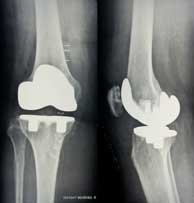The Gist
 Total knee replacement, also known as total knee
arthroplasty, is one of the most common and most expensive surgical procedures
carried out in the United States. It is a common treatment for knee pain
associated with osteoarthritis and similarly serious conditions. A newly
published study by the Journal of the
American Medical Association (JAMA)
takes a closer look at the sharp uptick in total knee replacement procedures
conducted in the United States during the past 20 years.
Total knee replacement, also known as total knee
arthroplasty, is one of the most common and most expensive surgical procedures
carried out in the United States. It is a common treatment for knee pain
associated with osteoarthritis and similarly serious conditions. A newly
published study by the Journal of the
American Medical Association (JAMA)
takes a closer look at the sharp uptick in total knee replacement procedures
conducted in the United States during the past 20 years.
The study, led by Dr. Peter Cram, MD, MBA, looked at almost
3.5 million procedures conducted since 1991 among the Medicare population (all
of whom are over age 65), and found that hospital stays for the procedure have
decreased in length during that time. However, there have also been increased
rates of infectious complications after the procedure, as well as increased
rates of readmission to the hospital in the month following the procedure.
The Expert Take
Dr. Brian Wolf, MD, MS, an Orthopaedic Surgeon and Associate
Professor at the University of Iowa Department of Orthopaedics and Rehabilitation,
and a co-author of this study, spoke with Healthline about the findings.
“We found that the number of people having total knee
replacements is going up even faster than the population of [Medicare age] is
increasing,” explained Dr. Wolf. There are a number of possible reasons for
this, including:
- a broader field of patients considered to qualify for the procedure
- higher prevalence of conditions that can result in osteoarthritis, and thus the need for total knee replacement, especially obesity
- the United States’ aging population
The increased use also has to do with the surgery’s success
rate, explains Dr. Wolf. “It’s proven to be an excellent operation in improving
quality of life,” he says. The risks and complications of total knee
replacement, as he explains, are relatively low—in the neighborhood of 4 or 5
percent—and have remained so for several years. For reasons such as this, surgeons
are more likely to consider knee replacement for an obese person today than
they would have been 20 years ago.
Beyond these facts, Dr. Wolf postulates that these trends in
the usage of total kne replacement reflect a population that is more active and
less tolerant of knee pain, especially given the success rate of this
procedure.
A significant, related discovery of this study showed that
the number of days people would stay in the hospital for this procedure dropped
dramatically in the time period studied: from an average of 9 to 3.5 days. This
number partly has to do with the economics of healthcare, says Dr. Wolf, but it
has a significant downside. “The downside to [this statistic] is that we
noticed more people didn’t necessarily go home after surgery, but rather went
to a field facility, nursing home, or rehab center.” As is discussed in the
study, there was a slight increase in the number of people who had to be
readmitted to the hospital within 30 days of surgery. In prior years, suggests
Dr. Wolf, conditions requiring readmission might have been caught earlier if
patients had stayed longer in the hospital.
No comments:
Post a Comment